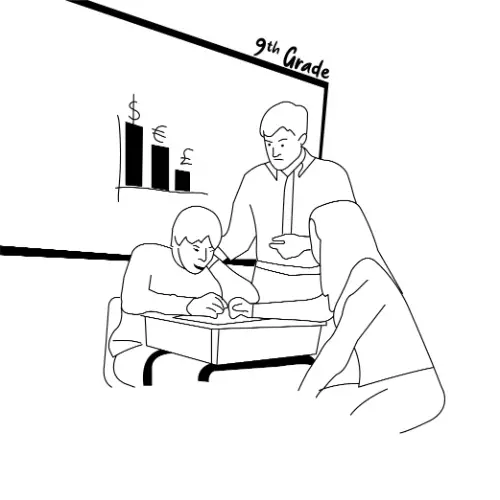Ninth grade is a crucial year in a kid’s academic career, particularly in their financial education. By this point, they have learned a lot about money awareness, wants and needs, supply and demand, and global trade. Now, they get into the nitty-gritty, breaking down economics as a science and seeing how the many working parts come together. The core topics they are introduced to in this grade are the foundations of economics, banks and banking, investments, budgeting, insurance, and taxes. Teachers who need effective lesson plans hitting these specific topics have the ideal resource a click away: the 9th grade money lesson plans page, where you can find the materials you need for your 9th-grade scholars.
If you want to bolster your curriculum and give your students even more chances to gain money knowledge, try using games and activities. Many sites and interactive platforms allow kids to expand their understanding of economics, providing real-life situations they can relate to and will experience soon. Let’s dig into the different resources available to 9th-grade teachers like you!
Online Games
As you search for online games and activities, you will find a vast assortment, so how do you know which to focus on and assign your students? By sticking to the standards and supplementing the core topics you teach in this grade, your kids will be on track to success, confidently moving up to the next level.
The Payoff
In this game, students play the role of video bloggers who want to compete in a video competition that could alter their future. Students need to use persuasion, manage their finances, and maneuver through the pre-competition process without making major mistakes with their money. The main characters are teenagers with modern-day interests and challenges, making this game fun and relatable for your 9th-grade learners.
Financial Football
This free game appeals to sports fans, video gamers, and teachers who want to engage their students with money topics through a fun activity. Users can choose football plays, call audibles, go for the long bomb, and more while learning and reviewing key economic concepts and seeing how to manage their money better. This game is a popular choice for many educators, and you can assign it to students in many situations.
Balance Your Checking Account
Balancing your checking account is a skill that will carry these kids throughout life, and this interactive activity is great practice for your 9th-grade students. Your kids need to balance their checkbooks by entering transactions in the register, filling in totals, and reconciling any differences when they get the wrong calculation. The game provides immediate feedback, helping students understand how the process works and where they may make mistakes so they are aware in the future.
Chair the Fed
9th-graders learn about the Federal Reserve, including what it does, how it sets policies, and why it intervenes in the economy. This game lets kids pretend to be in charge of the Fed, watching how their decisions impact the economy while aiming to decrease unemployment rates and keep inflation under control. These lessons apply to high schoolers’ lives and beyond, making this an excellent game to teach the topic.
Credit Clash
Credit scores are critical to financial health, and maintaining them is not an easy task. This game allows students to play around with different factors, seeing what changes their scores for good or bad, and understanding how debt affects people’s economic success. After you address this topic in your core lessons, this game is a great way to revisit the points you made about credit.
Hit the Road
This financial adventure game appeals to students, as they get to imagine going on a cross-country journey with their friends and spending money how they want. The catch? They have to be smart about managing their cash, or they will not make it to where they are heading, making this a fun and detail-oriented game. You can have your students play this during independent work, giving you another tool to bring in elements of all the lessons you have delivered throughout the year.
Plan’it Prom
Prom is a significant event in many high-school students’ lives, but kids may not have any idea of the costs involved. This interactive site lets learners see the various prices of components they need for the big dance, and they can use that information to plan the night.
STAX
Whether you want individual students to play this game or join with others to compete against each other, you will see the benefit of this activity. Kids make stock market decisions based on realistic variables during up and down markets and feel the pressure of significant decision-making and its impact on their portfolios. Many young adults think they need to catch the next rising star to get wealthy but may realize that long-term, steady growth could be the best approach.
The Stock Market Game
This rich, data-driven game shows your 9th-graders the inner workings of the stock market, giving them experience and practice to make intelligent investment decisions in the global exchange. This activity touches on virtually all of the primary topics of 9th-grade money education so that it can be an excellent ongoing review tool or a comprehensive assessment method. It is very customizable, giving teachers a choice to run the simulation over the course of a week, a month, or the entire school year.
The Uber Game
Many high school students are aware of gig economy jobs and think that their future may be with a rideshare, remote contract work, or food delivery, and there is nothing wrong with that aspiration. However, the time will come when you need substantial money now or you need that steady, consistent paycheck coming in, and this game shows the reality of the gig economy with actual numbers.
In-Person Activities
Often, students thrive with paper and pencil activities, and there are many worksheets and downloadable materials you can use to boost student money knowledge. Let’s check out some of the best options below.
Dream Big: Money Goals
This straightforward worksheet asks students to take a few minutes and plan those big goals. It breaks down the dream step by step, and students write down what they plan to do or learn along the way to their financial aspirations.
Defining Economic Terms
It is challenging to increase the complexity of a subject if your students don’t understand the language. These money terms are crucial to student comprehension, and the worksheet is doable for individuals or partners.
Your Own World Bank Loan
This activity mixes English skills, persuasion, and economic knowledge into one exercise, helping students develop a well-planned essay they can do independently. They need to request a loan for a community development project, showing them that empathy and financial knowledge can work together to achieve great things.
Making it Work: Money and Roommates
After high school, many of your students will go on to college or another house-sharing experience, and these situations can have conflicts between roommates. This worksheet presents several scenarios that roommates may encounter, and your 9th-graders start to figure out solutions.
The Art of Budgeting
Your 9th-graders are likely well aware of budgets and their importance but may not realize how much thought goes into successful ones. This activity breaks down each step, requiring students to list, calculate, and reflect upon why they make decisions in each section.
Living On Your Own
Now that your 9th-graders are in high school, they’re probably dreaming of the next chapter after graduation, and a significant part of that step is housing. This sheet goes through the costs, responsibilities, and benefits of living independently, preparing students for their lives ahead. You can choose to have kids work alone or in pairs to bounce ideas off each other and make sure they account for every expense.
Banking Services
By the end of this school year, your kids will have been exposed to banks and banking services, and this activity enhances that knowledge. Your learners must research local banking information, determine what services they will use from the bank, and learn how to fill in and balance a checkbook.
Credit Cards Activity
Credit cards offer advantages and drawbacks to adults; the earlier you expose students to these facts, the better. This activity asks students to compare various credit cards, review essential terms like APR and grace period, determine total costs with interest included, and analyze credit card statements to show what they have learned throughout the year.


